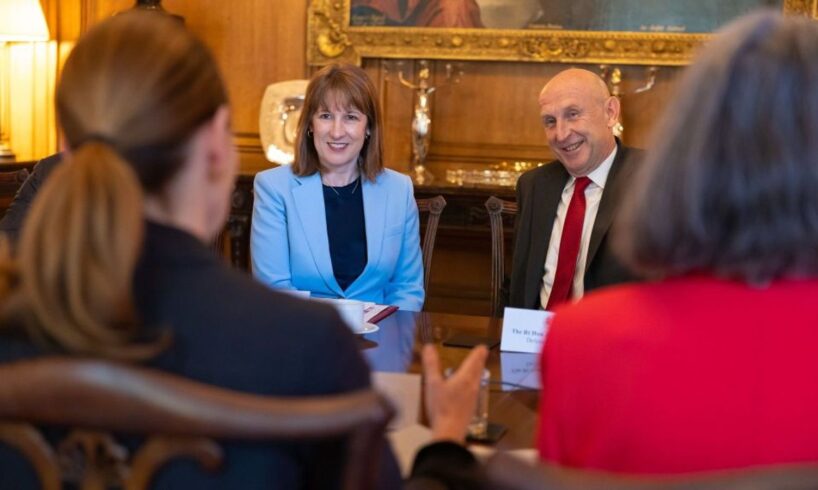
The main parliamentary parties, led by Labour, are banging the drum for preparations for war with Russia, regardless of the immediate outcome of the conflict in Ukraine.
Not a day goes by without the Labour government intensifying preparation for such a catastrophic war. This is taking a public form in the run-up to the government’s autumn budget to be delivered this week by Chancellor Rachel Reeves.
Vocal sections of the military are vying for a greater share of total government spend of around £1.2 trillion. Currently, military spending, as defined by NATO, takes up £65.8 billion. The government is committed to increasing this from its current level of 2.3 percent of GDP to 2.7 percent by 2027 and 3.5 percent by 2035. This is part of overall plans to have 5 percent of GDP going on military spending and accompanying infrastructure/national security by that date.
The Chancellor of the Exchequer and the Secretary of State for Defence hold a roundtable with the Defence & Economic Growth Taskforce, May 28, 2025 [Photo by HM Treasury / CC BY-NC-ND 2.0]
While essential social and health services are to be further starved of resources and transformed into revenue streams for private capital, arms spending is to surge to at least £101 billion.
Speaking last week in Downing Street, Defence Secretary John Healey fed a media frenzy over the presence near UK waters of a Russian research vessel Yantar, which he accused of monitoring the UK’s undersea cables.
Healey said the world was “in a new era of threat” before listing the Iran—Israel war, conflict between India and Pakistan, and Chinese spies “targeting our democracy”. Russia was escalating “war in Ukraine”, while Europe’s skies were “plagued by drone disruptions…” There were Russian incursions into NATO airspace” and intimating Russia was responsible, “90,000 cyber-attacks on the UK Defence system alone.”
Healey hailed Labour’s role in re-integrating the British military into the efforts of its European rivals and allies. Under his watch, a UK-EU Security and Defence Partnership had been established along with “UK leadership of the Ukraine Defence Contact Group”, the Trinity House Agreement with Germany and a “reboot of the Lancaster House agreement and treaty with France.”
Such are the conflicts within Europe as to which corporations will win the lion’s share in an escalation of military spending by government, that within days of Healey’s speech it was reported by the Financial Times that Britain “has offered a fraction of Brussels’ €6.7bn demand to join the EU’s €140bn rearmament programme, suggesting it contribute just €75mn.” It cited a UK government official declaring “It is not reasonable for the UK to pay additional costs to the EU just for the privilege of our industry supplying EU customers’ equipment at market prices.”
Healey insisted there would be a “defence dividend” measured in “good jobs, growing businesses and new skills across the UK.” At the end of the Cold War, both Conservative and Labour governments promoted a “peace dividend” and the prospect of increased social spending rather than on military preparation for nuclear war. Healey now offers an arms spending bonanza and lucrative profits for arms companies, boasting that 1,000 major defence contracts had been signed and billions in investment and exports approved. He announced a programme to “manufacture munitions and explosives”, opening on the same day a new sea and undersea drone factory in Plymouth.
Loading Tweet …
Healey said Britain under Labour would “rearm in the face of threats” and “boost our defence industry, adding, “That’s what this budget will be about: strong foundations to secure Britain’s future. Delivering for defence. Delivering for Britain.”
But, as aired in the many shrill complaints of military top brass—and their media mouthpieces—since the outbreak of war in Ukraine, British imperialism needs far more. Due to the legacy of major post-Cold War cuts in military spending its armed forces operate on a shoestring—with a regular army of barely 70,000 troops that could not fill London’s Wembley Stadium.
Addressing this crisis, last month the House of Commons Defence Committee published “The UK Contribution to European Security” report, produced by Labour, Conservative and Liberal Democrat MPs with assistance from the arms industry and academia. Inevitably framed as a response to “Russian aggression”, the report warned that the “UK’s industrial base is not yet configured for sustained collective defence”, that investment capital—“defence finance”—must be made available. It complained that the “national conversation on defence and security” promised by Prime Minister Keir Starmer had yet to start.
The report called for further efforts to ensure that the government “accelerates and further deepens defence and security cooperation with the EU and European partners, particularly France” on the threat posed by Russia and China. It warned that the US upcoming National Defence Strategy is likely to swing further to the Indo-Pacific and “defence of the US homeland”.
From the standpoint of the European powers, it warned “there may well be a crisis elsewhere in the world which results in the US withdrawing capabilities from Europe overnight and Europe being left vulnerable.” The UK government should “ensure that it plays a leading role and expends every effort to hold the NATO Alliance together.”
One request was that the government set out its reasoning for dismissing, thus far, a second “sovereign” (i.e. independent of the US) means of delivering nuclear weapons strikes. Currently the UK can launch ballistic missiles from the one Trident submarine—of a fleet of four—in a “Continuous At-Sea Deterrent”. Each submarine can deliver the destructive power of 320 Hiroshima bombs.
The report cited evidence it received from a UK Delegation to the NATO Industrial Advisory Group which “told us that there was significant risk in the ability of the industrial base to respond to and sustain the increased demands of collective defence…” The British arms industry operated too slowly, was too small, and hampered by low production volumes, supply chain bottlenecks and a lack of alternate suppliers. As a result, it may not be able to cope with the demand surge imposed in a major conflict, particularly should US attention be directed elsewhere. A major problem was that the US currently produces more munitions than “all of Europe combined”.
The six new munitions factories announced by Healey, at 13 possible locations, first trailed in this year’s National Security Strategy, will be tasked with building munitions stockpiles including up to 7,000 long range missiles.
The report also highlighted problems integrating British built missiles into US-made F-35B jet fighters used by the UK. It warned of a skills gap without continuous production of Typhoon jet fighters, and complained of a “zoo” of NATO equipment supplied by the arms industries of its member countries.
In the section detailing Integrated Air and Missile Defence, the report cited chilling remarks from the testimony it received from an Exeter University academic, Peter Roberts: “There has been no political will to make the difficult decisions, or to be honest with the public and say, ‘We’re not going to stop missiles coming and hitting you. A set of you are going to die, hospitals are going to go under, and you will be without food, water, sewers and electricity’”.
A conference being held this week by one of Britain’s premier think-tanks is devoted to resolving the war preparations crisis of the ruling elite. The Royal United Services Institute (RUSI), the UK’s main military think-tank is hosting, “The Long War Conference 2025”, with conference speakers to include retired general Sir Richard Barrons and Defence Readiness and Industry Secretary Luke Pollard. Participating are industry figures, and other parliamentarians who will examine four core themes: The threat of long war; Reconstitution and the role of reserves; Industrial preparedness; and rearmament and Whole-of-society resilience, with reference to the Defence Readiness Bill.
The conference, to be held on Tuesday—one day before Reeves’ budget—notes that “RUSI’s Military Sciences team is launching a flagship programme, Long War, exploring how the UK and its allies can sustain conflict beyond the first battle. With the prospect of peer conflict on the horizon, this initiative asks how forces can be mobilised, reconstituted and sustained across a protracted, industrial-scale war.”
A preparatory paper by RUSI “defence engagement manager” and former Tory parliamentary secretary Hamish Mundell, “The Long War: Fighting Beyond the First Battle”, makes clear the character of the discussions being held.
He writes, “Despite clear recognition of the requirement for improving future combat power, there remains little evidence that the UK has a plan to fight a war lasting more than a few weeks.” There was a “first battle bias” meaning UK war planning tended to be focused on forces that can be rapidly deployed. There was less interest in “less demonstrable forms of resilience such as reserve forces, deep stockpiles and industrial mobilisation.” Moreover, “[m]edical capacity is limited. Reserve regeneration pipelines are slow. There are no clear arrangements for reconstituting high-value capabilities or training sufficient replacements.”
This has to change. “A long war requires more than just a first echelon of high-readiness forces. It demands a second and even third echelon; personnel, platforms and logistics chains that can absorb losses and continue the fight. Yet this depth is notably absent from current British force design.” To resolve this, Mundell called for “stockpiles, industrial surge capacity, casualty replacement and renewed legal frameworks for mobilisation”—in other words, vast rearmament and barely disguised conscription.
Join the fight for socialism!
Fill out the form to be contacted by someone from the WSWS in your area about getting involved.





